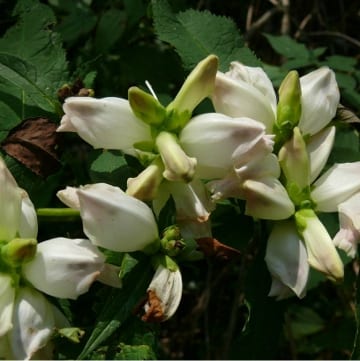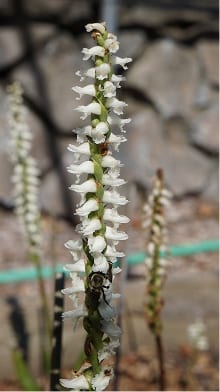by Kathleen Salisbury
As you spend the winter planning additions for your landscape and troll through the countless catalogs you have been getting in the mail, it is easy to think about the colorful spring blooms that put an end to the dull winter months. However, as you plan, don’t forget the late blooming flowers! Order them as well to ensure a landscape that is not only interesting in all seasons but offers food for wildlife as they prepare for migration or the lean winter months.

Mixing and matching Asters including Heath Aster (Aster ericoides) in the garden can extend bloom into November.
Late blooming flowers are essential in a landscape that aims to provide late season food to migrating song birds and insects preparing to make it through a deep freeze in a few weeks. The nectar from these flowers provides much needed energy to insects, while ensuring a crop of seeds and the next generation of native flowers. Insects attracted to these plants and their seeds provide a high energy food source to many types of birds including those that fly south for the winter and those that call Duke Farms home, no matter what the season.
Duke Farms, a 2742-acre estate in Hillsborough, NJ, was developed by tobacco and hydropower magnate James Buchanan Duke beginning in 1893. Compiled from more than 14 parcels of farmland, Duke Farms is now one of New Jersey’s largest privately-owned open spaces. As stewards of this land, Duke Farms Foundation is working to regenerate healthy diverse habitats of native plants and animals, develop farmland using sustainable practices and create demonstration garden for the education and enjoyment of others.
Some late blooming flowers we enjoy at Duke Farms and that you should consider for home landscapes are:
Asters (Symphyotrichum) – Flowering in shades of white, pinks, and purples these perennials can extend the bloom time of your gardens well into November. There are a number of Asters native to the Northeast; be sure to mix and match to have color throughout the fall.
Goldenrods (Solidago) – These yellow bloomers come in various heights and are suitable for a number of growing conditions from wet shade to dry sun. There are a number of Solidagospecies native to the Northeast, be sure to include multiple species to ensure that your trees are not the only plants offering fall color this season. Remember goldenrods DO NOT cause hayfever!
Perennial Sunflower (Helianthus) – This relative of the big bright sunflowers we see at the florist shop returns year after year. Not only do the flowers last into fall after an early summer start, the seeds are prized by many types of wildlife.
Sneezeweed (Helenium autumnale) – This is a must for any sunny fall garden. Covered with yellow daisy-like flowers on stiff stems, this perennial is great for cut flowers and is rumored to repel rabbits!
Turtle Head (Chelone lyonii or C. glabra) – Have a moist shady area in need of some color in this fall? This is the plant for you! Turtle head’s white or pink flowers emerge along a stiff central stalk. The lower resemble the head of the turtle, which is where this perennial earned its common name. Not only is this plant interesting in the fall, but as it emerges in the spring the leaves are a beautiful bronze color.
Ladies’ Tresses (Spiranthes odorata) – Can you believe there is a NATIVE fall blooming ORCHID you can include in your landscape? If you have a boggy area in shade, plant this beauty for white blooms until frost. If given the right growing conditions, this plant will spread throughout your garden.
Witch Hazel (Hamamelis virginiana) – The only shrub on the list, you may be familiar with witch hazel as a remedy for any number of ailments from skin blemishes to swelling. While we are not doctors and cannot confirm the medicinal qualities of this plant, we certainly can attest to the beauty this shrub adds to the autumn garden. Often the spidery flowers are overlooked due to the competition from every tree in the forest putting on a colorful show in the form of a spectacular leaf display. But if you take a closer look at the large shrubs of your local forest you just may find bright yellow flowers scattered here and there along the branches.
Anise Hyssop (Agastache foeniculum) – Deer resistant, blooms until frost, attracts pollinators, hummingbirds and butterflies, and comes back every year! What more could you ask for in a plant? Be sure to include this one around your home and even put it close by where you can crush a leave or two to enjoy the scent of anise.
Remember when planning your own landscape as a habitat for wildlife, diversity is key. By ensuring you have many species of native plants blooming throughout the year you will ensure a diversity of wildlife in your garden. The trick to attracting winged wildlife is to make sure they can see your offerings from above. Plant your natives in groupings of three or more, the large area of color will indicate to small eyes above that you have food for them below. Enjoy the autumn color of leaves, wildlife and even flowers whether at Duke Farms or in your own back yard!
About the Author
Kathleen Salisbury is the Team Leader of Education at Duke Farms Foundation in Hillsborough, NJ. Duke Farms serves as a model of environmental stewardship and inspires visitors to become informed stewards of the land. It is a place of education, enjoyment and research that enhances the environmental health of the region. At Duke Farms, Kathy is responsible for teaching the public about Duke’s stewardship projects and practices and how to replicate them in a residential landscape. She also develops and implements innovative educational programming for families, adults, and professionals. In addition, she is president of the Native Plant Society of New Jersey. Kathy has a BS in Ornamental Horticulture and Environmental Design from Delaware Valley College and a MS in Public Horticulture Administration from the University of Delaware where she was a Longwood Fellow. She may be reached at ksalisbury@dukefarms.org.




